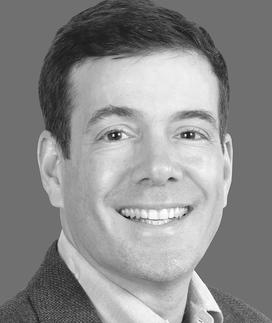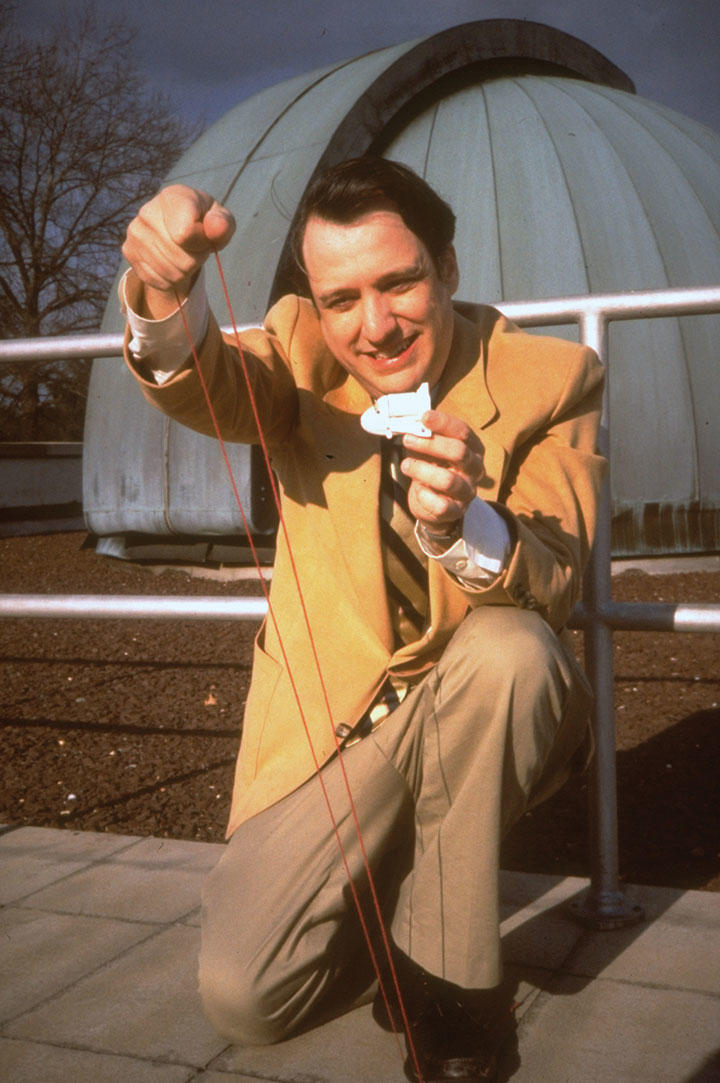Essay: Learning to Travel Through Time With My Astrophysics Professor
By Mark Alpert ’82

For 35 years I’ve been traveling through time with the Princeton professor who showed that time travel is possible.
It’s 1981. I’m a senior in the astrophysics department, choosing a topic for my undergraduate thesis. I’m in the Peyton Hall office of J. Richard Gott III *73, an astrophysicist who’s building a reputation as one of the best and quirkiest teachers at Princeton. I’m 20 years old, he’s 34.
Professor Gott is a native of Louisville, Ky. He studied math and physics at Harvard before getting his Ph.D. in astrophysics at Princeton. He has a strong Kentucky drawl and a special enthusiasm for Albert Einstein’s general theory of relativity, the equations that link space and time and gravity. He leans forward in his chair and fervently talks about curvature tensors and spacetime metrics. And as I listen to him, I start to feel the same excitement.
He finds a recent issue of Scientific American and opens the magazine. “Here’s something interesting. It’s about Flatland, a hypothetical universe with only two spatial dimensions. It has length and width, but no height. You could do a thesis on that.”
I’m confused. “Flatland?”
“You could figure out how general relativity would work in a universe with only two spatial dimensions, plus the dimension of time.”
He draws a spacetime diagram to make things clearer. The vertical dimension in this diagram is the dimension of time. The top of the page is the future, and the bottom is the past. Every object in our universe follows a “world line” in this diagram, moving left and right through the spatial dimensions but also traveling inexorably upward, toward the future.
That meeting in Peyton Hall is the beginning of our journey. My world line and Professor Gott’s run close and parallel for the next six months as I struggle with the mathematics of relativity. I finally derive a solution for Flatland and rush to Dr. Gott’s office. He smiles and gives me the highest compliment that one theorist can give another: “This solution is non-trivial!”
The theory of relativity, we discover, would work very differently in Flatland than it does in our universe. There would be no gravitational attraction between massive objects, and yet those objects still would alter the geometry of the spacetime around them. It’s an interesting result. Dr. Gott and I co-author a research paper that’s published in a somewhat esoteric journal called General Relativity and Gravitation.
After I graduate from Princeton, though, I stop studying astrophysics. I fall in love with poetry and get a master’s degree in creative writing. Eventually I become a journalist. My world line diverges from Professor Gott’s.
But then something remarkable happens. My Princeton education isn’t over yet. Our world lines come back together.
It’s 1998. Oddly enough, I’m now an editor at Scientific American. My wife and I go to the American Museum of Natural History in New York City to hear a lecture by Dr. Gott. He’s made an amazing discovery: Under extraordinary circumstances, the theory of relativity allows for time travel to the past. The circumstances involve cosmic strings, infinitely long strands of high-density material that may have been created in the first moments of our universe’s history. If cosmic strings really exist — astronomers haven’t observed any yet — Professor Gott believes they could be used to build a time machine.
With his usual enthusiasm, he explains to the audience in the lecture hall how the time machine would work. First, you’d have to find two cosmic strings that are zooming past each other at nearly the speed of light. Then you’d jump into a spaceship and steer around the pair of strings in a tight circle. Because the strings radically change the geometry of the surrounding spacetime, the rocket would return to your starting point at a time before you embarked on the journey. Upon your arrival, you could shake hands with your slightly younger self and reassure him or her that the trip will be successful. Your world line has twisted into a closed curve, allowing you to loop back to an event in your past.
But wait, Dr. Gott tells the audience, there’s more! Researchers have discovered other methods of time travel allowed by Einstein’s equations, including scenarios involving wormholes — shortcuts through spacetime, like the one shown in the movie Interstellar — and exotic vacuum states. “I’m not talking about a Hoover vacuum,” Gott says passionately in his characteristic drawl. “I’m talking about a negative-energy quantum vacuum!” Even stranger, it’s possible that our universe began as a closed time loop, a vacuum state that whirled back and forth in time and simultaneously sent a branch of spacetime into the future, where it became our modern-day cosmos.
This cosmological model is appealing to physicists and philosophers because it cleverly answers an age-old question: What started the universe? If our cosmos branched off from a closed time loop, then the universe has no beginning, because every moment in time is preceded by an earlier moment. There’s no need to imagine a cosmic birth that created everything out of nothing, because it didn’t happen. Instead, the universe created itself.
These ideas about time travel and cosmology dazzle the audience at the museum. After the lecture, several people rush toward the stage to talk to Professor Gott. My wife pushes me forward. “Go on, say hello to him.”
Researchers have discovered other methods of time travel allowed by Einstein’s equations, including scenarios involving wormholes — shortcuts through spacetime, like the one shown in the movie Interstellar — and exotic vacuum states. “I’m not talking about a Hoover vacuum,” Gott says passionately in his characteristic drawl. “I’m talking about a negative-energy quantum vacuum!”
I shake my head. “No, he won’t remember me.” But I go to the stage anyway and say hello.
He smiles. “Of course, I remember you! That research we did together? On Flatland? That led to my work on cosmic strings.”
As it turns out, the spacetime around a cosmic string is very similar to the distorted geometry around massive objects in Flatland. When Dr. Gott tells me this, I sense a strange tug in my own world line. I’m looping across time.
Einstein, in one of his last letters: “The distinction between past, present and future is only an illusion.”
It’s 2007. I’m having lunch with Professor Gott at a Chinese restaurant near Princeton. We’ve stayed in touch over the past decade; we follow each other’s work and occasionally discuss the latest science news. The relationship is incredibly rewarding. I feel as if I’ve enrolled in an open-ended astrophysics course that has no final exam but keeps giving me credits.
I arranged this lunch so we can discuss a manuscript I’ve written. It’s my first novel, Final Theory, a thriller about Einstein and apocalyptic physics. Dr. Gott has scribbled comments on dozens of Post-It notes. He points at the novel, which has several physicists in its cast of characters. “Well, I recognize which character is me,” he says. “And I know which one is you. So who should play us in the movie?”
He has a soft spot for science-fiction movies, especially any film that features time travel. After we go over the casting choices, Dr. Gott corrects several mistakes I made in the first draft of the novel. In one scene, I put the wrong constellations in the summer sky. That would’ve been a humiliating error for a former astrophysics major.
It’s 2015. I’m in Professor Gott’s office again, but now my 16-year-old son, Tommy, is there too. He’s thinking about applying to Princeton and wants to meet my favorite teacher.
Dr. Gott is generous with his time. He gives Tommy a tour of the astrophysics department. He tells stories about the Intel Science Talent Search, the contest for which he served as a judge for many years. (He was a contestant when he was in high school, winning second place in 1965.) Then he switches gears and talks about space exploration and the War of the Worlds broadcast, the famous Orson Welles radio play that terrified the country in 1938 by describing a Martian invasion of New Jersey. He says he recently celebrated the anniversary of the broadcast by visiting Grover’s Mill, the site of the fictional Martian landing. It’s just a few miles from Princeton.
He keeps us enthralled for almost two hours. After we leave Peyton Hall, Tommy is thoroughly intimidated. “If you have to be that smart to get into Princeton, I don’t have a chance,” he says.
I reassure him by pointing out that very few people in the world are as smart as Professor Gott.
It’s 2016. In one of the most important discoveries of the century, scientists detect gravitational waves for the first time, providing the best evidence yet for the theory of relativity. And at the end of the spring semester, Dr. Gott will retire from the Princeton faculty. I’m 55 years old, he’s 69.
I’m glad we stayed in touch. I tell all my friends and fellow alumni that they should look up their former professors. It’s like another kind of time travel.
And you don’t even need any cosmic strings.












1 Response
Emil Friedman *73
9 Years AgoPondering Time Travel
Re “Learning to Travel Through Time With My Astrophysical Professor” (On the Campus, May 11): Is Professor Richard Gott ’73’s time-travel example two-way? After going back to the past, can he return to the future? What about the paradox proposed by Larry Niven? If a method of traveling to the past were discovered, would somebody go back and do something to prevent the discovery? (One-way time travel to the future is clearly possible. All of us do it continuously.)